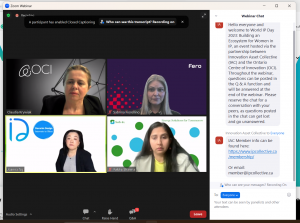It’s amusingly tempting for me to blame society’s mental image of a scientist on Thomas Dolby!
His music video, She Blinded Me with Science, takes place at a facility named the Rest Home for Deranged Scientists. The video is filled with unfortunate visual stereotypes, from the secretary to the scientist.

A montage of famous scientists and inventors conveys the stereotypical image we usually think of the most.
No, it’s not all his fault. Yes, our mental image of the modern scientist or inventor has long needed to change.
They are not all crazy white guys!
Although that stereotypical image has been around a long time, and you can see it almost everywhere, it is neither totally representative nor very inspiring. You must work to find images of women inventors or scientists. That long-encountered glass ceiling in the workplace obscures the view.
And as a panel of successful women inventors, scientists, engineers and tech business leaders all underscored in one way or another: Representation matters. Representation breeds impersonation.
“We need to see ourselves [women] in these roles,” said one accomplished female tech exec. “If they [other women] don’t see you do it, they won’t believe they can do it,” said another women executive of the importance of role models and the unfortunate impact of existing stereotypes on students or those just entering the workforce.
“We cannot be what we cannot imagine,” said another panellist (who happens to hold dozens of patents for her technical innovations and inventions).
They were all participants in an online forum titled Building an Ecosystem for Women in IP, presented by the Ontario Centre of Innovation (OCI) and the Innovation Asset Collective (IAC).
(OCI is a Canadian not-for-profit organization that works with industry, government, and academia to accelerate the commercialization and adoption of new technologies. The IAC is an independent, membership based not-for-profit assisting small and medium-sized enterprises in Canada with their IP needs, including access to funding for IP development and education.)
Of course, there are women working in technology, developing products, creating intellectual property, building successful companies. There always have been, often found in unexpected places. But the opening question to the panellist put a sobering, realistic light on the subject:
“Why is the number of women inventors and patentees so low?”
Dr. Claudia Krywiak, President and CEO of OCI and moderator of the panel, started the discussion with that query. Citing recent statistics to back up her question, Dr. Krywiak noted that the share of patents granted to one woman inventor rose only slightly in recent years, from 20.7 to 21.9 per cent.
“That’s too slight an improvement” when compared to overall gains realized by women through various education and employment opportunities in STEM, she said. And worse still, the proportion of patents or shared patents held by women is a low 12.8 per cent.
Prior to joining OCI, Krywiak was Vice President, Business Development at Mitacs, a national research organization that funds research and training programs, so her work experience and career trajectory means she knows of what she speaks. While at OCI, she has brought together business growth and development partnerships among government reps, educational institutions, high-tech sector anchor firms and start-ups companies (led by men and women) in emerging technology areas like artificial intelligence, autonomous vehicles, 5G and next generation telecom networks, cybersecurity, and clean tech.

A screen grab from the online forum Building an Ecosystem for Women in IP, presented by the Ontario Centre of Innovation (OCI) and the Innovation Asset Collective (IAC). Clockwise from top left: Dr. Claudia Krywiak, OCI’s President and CEO moderator; Sabrina Fiorellino, JD, Chief Executive Officer, Director, Co-Founder, Fero International Inc.; Joanna Ng, Founder, Devarim Design; Rekha Sharma, Chief Executive Officer, Solv4X.
Replying to that opening question was panel participant Joanna Ng; she’s the founder of Devarim Design, based in Markham ON, a company involved in AI, IoT, blockchain and augmented cognition applications.
That’s after her long and successful career in high-tech, perhaps most notably a multi-year tenure as the Head of Research and Director of the Centre for Advanced Studies, IBM Canada Lab; she’s accredited as an IBM Master Inventor and there are some 49 patents granted in her name.
Noting the small percentage of women overall in STEM fields, and as working inventors, she was not all that surprised at the low number of female patentees. Even with her own patent portfolio, Ng – as do many other successful women – fell victim to the “imposter syndrome”, a feeling that despite accomplishment and high performance, one is not rightfully recognized as successful due to industry stereotypes and misrepresentation.
Good representation breeds inspired impersonation, and while gender generalization is never wise, Ng shared a revealing observation gleaned from her years in the industry: “Many women take joy in solving problems, working together in making a real difference in people’s lives. We’re not as much interested in claiming territories, especially with Intellectual Property. I had seven or eight patents and did not call myself an ‘inventor’.”
Take the example of the first person on the Moon, she proposed. If a woman, she would first rejoice and high five her companions and colleagues. If a man, the first thing to do is plant a flag – in silence.
How to tackle such stereotypes and the marginalization that can result?
Rekha Sharma, Chief Executive Officer at Solv4X, a Calgary company developing in AI-powered energy solutions. Building on her more than 15 years experience in energy markets, grid reliability, transmission and distribution, as well as power plant design, she cited two possible approaches to solving the shortage:
One is ground up, nurturing people, inculcating knowledge and behaviour from the beginning, giving confidence to students entering the field so right from high school they know a tech career is a possibility. Building confidence is like instilling values; it needs to start early as a way to help stave off that “imposter syndrome”.
Representation does matter. It helps to see other people who look like us doing what we want to do, and that’s certainly true for women looking at career opportunities in high tech and IP.
That being said, there are also serious systemic challenges that women must face and overcome in the tech world.
Dr. Krywiak cited statistics about money matters: funding, especially from venture capital sources, is a necessary and needed component of commercialization, she said. But women receive less than two per cent of VC funding – and that number is decreasing!
Serial entrepreneur Sabrina Fiorellino addressed the issue from her experience gained launching, funding and successfully exiting several tech companies, but also from her 10 years as counsel at two large firms on Bay Street.
Not practicing anymore, IP and IP strategy is now top of mind for her as CEO at Fero International, a healthcare infrastructure firm based in Hamilton, ON.
“It’s very expensive to patent your IP,” she said. “Sometimes, you have to choose revenue generation over IP filings” and push out and delay the costs related to IP protection, which can be risky in itself.
It makes the statistical reality, cited by the panel, that just one-point-six (1.6!) per cent of VC funding goes to firms with women in sole ownership that much more painful (as does the corollary that most VC firms are run by men, bringing up that representation and imposter problem yet again).
“I was intimately involved in the inventions that we filed for at my company,” Fiorellino described, “and I decided to not put my name down as an inventor. At the time, I thought it was insignificant; it’s complicated, there were multi-inventors and listings. But in retrospect, it was a mistake. I should have put my name in, I should have been there to help, even with the statistics.
“If people don’t see you, they’re not going to believe they can achieve it either…” she underscored of the need to see role models in the position of a tech leader or inventor or other desired position.
Facing such issues of representation and systemic inequity, the next question for the panel asks “What can we do to help the next generation of women in IP?”
Certainly, the panel itself is one answer. Role models who demonstrate to people – young women in particular – that they can and do have a place in the tech industry, leading product innovation and invention, securing the resources needed for market development and corporate growth, managing and benefiting from a valuable portfolio of held and granted patents, are invaluable.
From the inspirational to the foundational, this panel of women in IP is one example of local, national and international initiatives to empower women in younger generations to confidently push the boundaries of their sector and change the mentality of our industry.
The sponsor organizations are another big help, as the women all noted: IAC helps Canadian companies understand the importance of IP and how to build formidable IP and data positions to support their growth; OCI provides information, connections and funding resources to commercialize made-in-Ontario IP.
-30-
More STEM articles



